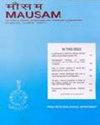A Machine Learning Approach for Probabilistic Multi-Model Ensemble Predictions of Indian Summer Monsoon Rainfall
IF 0.7
4区 地球科学
Q4 METEOROLOGY & ATMOSPHERIC SCIENCES
引用次数: 1
Abstract
Due to the uncertainty associated with Indian summer monsoon rainfall (ISMR), probabilistic seasonal forecasts which can convey the inherent uncertainty of ISMR are more useful to the user community than a single deterministic forecast. While such probabilistic seasonal forecasts can be produced from general circulation model (GCM) output, one single model generally does not represent all sources of error. The probabilistic multi model ensemble (PMME) is a well-accepted way to improve on the skill of probabilistic forecasts by individual GCMs. PMME can be constructed with one of two approaches: non-parametric, or parametric with respect to the occurrence of three categories of seasonal total rainfall—below, near, and above normal as defined by the climatological base period. Both the methods have their limitations. Non-parametric PMME use a smaller ensemble size which results in overconfident forecasts, and parametric PMME make the inaccurate assumption that total rainfall follows a Gaussian distribution. To avoid these problems, we propose the use of the Extreme Learning Machine (ELM), a novel machine learning (ML) approach, to construct PMME for ISMR forecasting. ELM is a state-of-the-art generalized form of single-hidden-layer feed-forward neural network. However, since the traditional ELM network only produces a deterministic outcome, we use a modified version of ELM called Probabilistic Output Extreme Learning Machine (PO-ELM). PO-ELM uses sigmoid additive neurons and slightly different linear programming to make probabilistic predictions. The performance of such PO-ELM based PMME is assessed rigorously in terms of Generalized Receiver Operating Characteristic scores and reliability diagrams over a 37 years period spanning from 1982 to 2018 following a leave-three-year-out cross-validation scheme. It is demonstrated that our new strategy for PMME based on ML is capable of producing skillful MME forecasts over large regions of India.印度夏季风降雨概率多模式集合预测的机器学习方法
由于印度夏季季风降雨(ISMR)的不确定性,概率季节性预测可以传达ISMR的固有不确定性,对用户群体来说比单一的确定性预测更有用。虽然这种概率季节性预测可以从环流模型(GCM)的输出中产生,但一个单一的模型通常不能代表所有的误差来源。概率多模型集成(PMME)是一种公认的提高单个GCM概率预测技能的方法。PMME可以用两种方法中的一种来构建:非参数的,或者关于三类季节性总降雨量的出现的参数的——低于、接近和高于气候基期定义的正常值。这两种方法都有其局限性。非参数PMME使用较小的集合大小,这导致过度自信的预测,而参数PMME则不准确地假设总降雨量遵循高斯分布。为了避免这些问题,我们建议使用极限学习机(ELM),这是一种新的机器学习(ML)方法,来构建用于ISMR预测的PMME。ELM是一种最先进的单隐层前馈神经网络的广义形式。然而,由于传统的ELM网络只产生确定性的结果,我们使用了ELM的修改版本,称为概率输出极限学习机(PO-ELM)。PO-ELM使用S形加性神经元和略有不同的线性规划来进行概率预测。这种基于PO-ELM的PMME的性能在1982年至2018年的37年期间,根据广义接收器操作特性得分和可靠性图进行了严格评估,采用了三年外交叉验证方案。研究表明,我们基于ML的PMME新策略能够在印度大地区进行熟练的MME预测。
本文章由计算机程序翻译,如有差异,请以英文原文为准。
求助全文
约1分钟内获得全文
求助全文
来源期刊

MAUSAM
地学-气象与大气科学
CiteScore
1.20
自引率
0.00%
发文量
1298
审稿时长
6-12 weeks
期刊介绍:
MAUSAM (Formerly Indian Journal of Meteorology, Hydrology & Geophysics), established in January 1950, is the quarterly research
journal brought out by the India Meteorological Department (IMD). MAUSAM is a medium for publication of original scientific
research work. MAUSAM is a premier scientific research journal published in this part of the world in the fields of Meteorology,
Hydrology & Geophysics. The four issues appear in January, April, July & October.
 求助内容:
求助内容: 应助结果提醒方式:
应助结果提醒方式:


